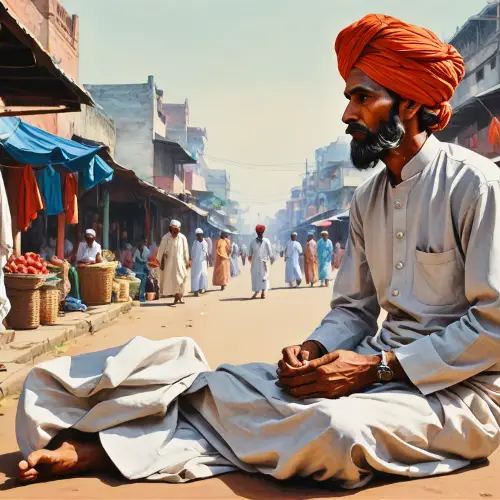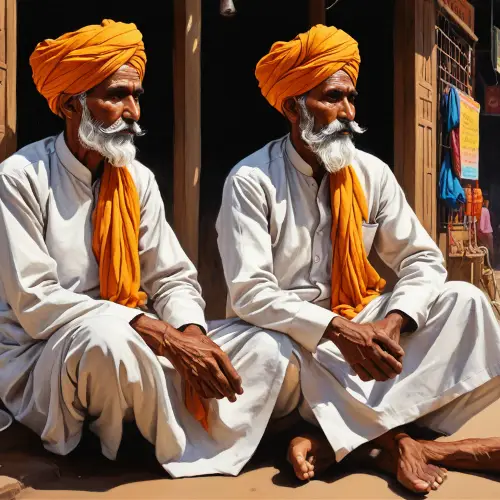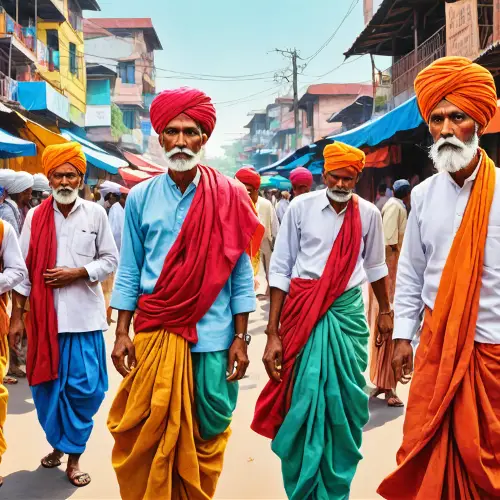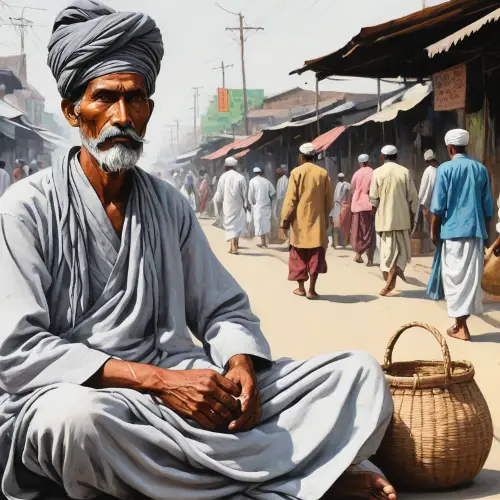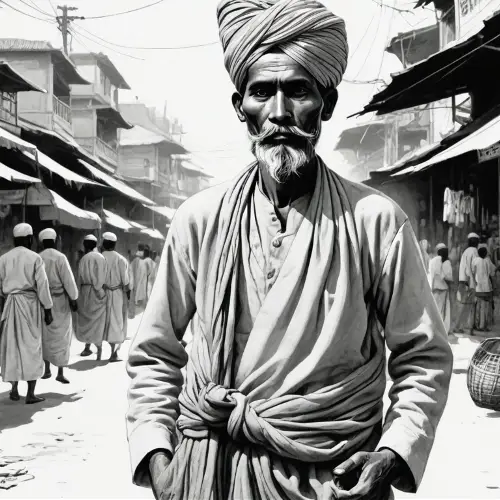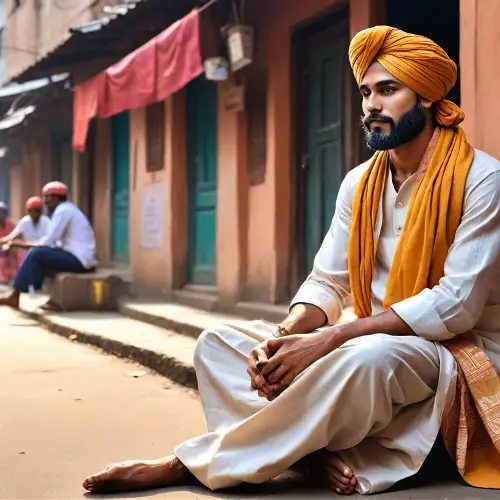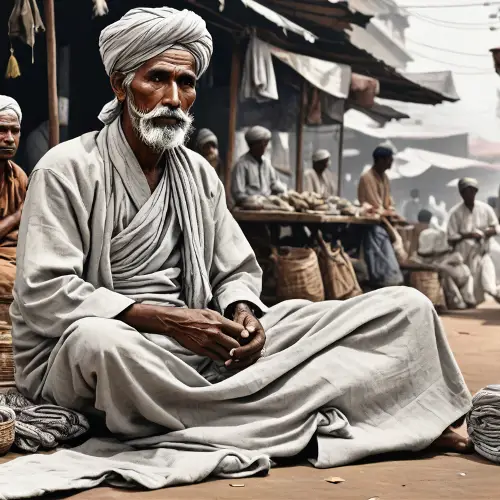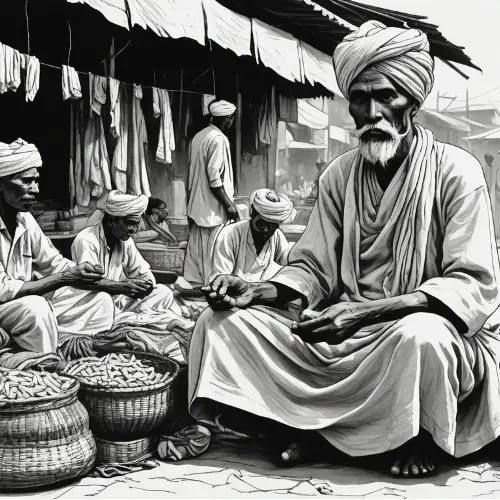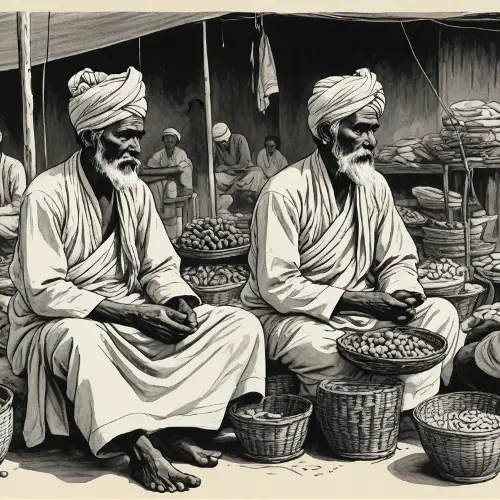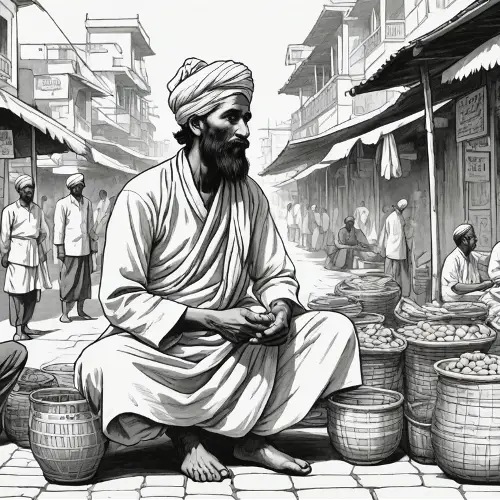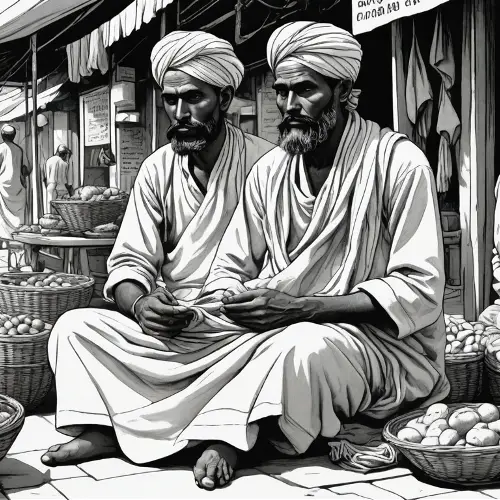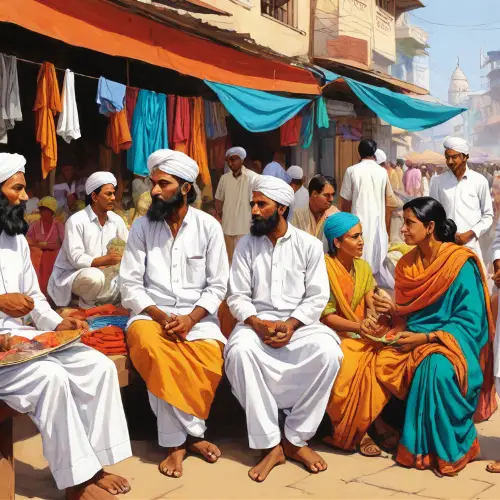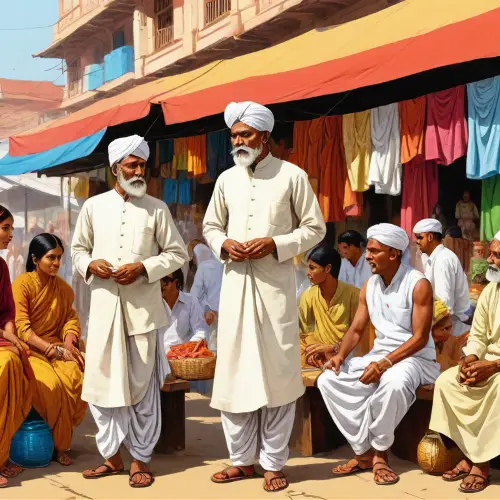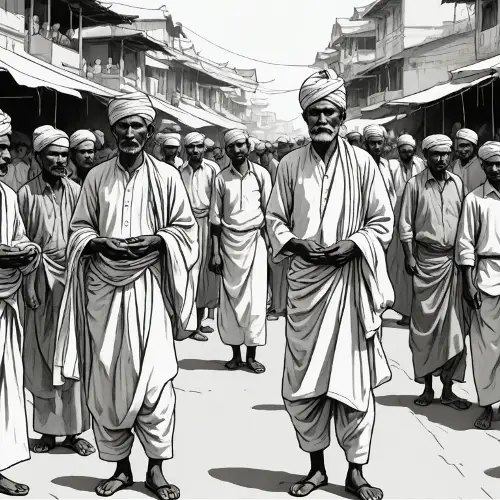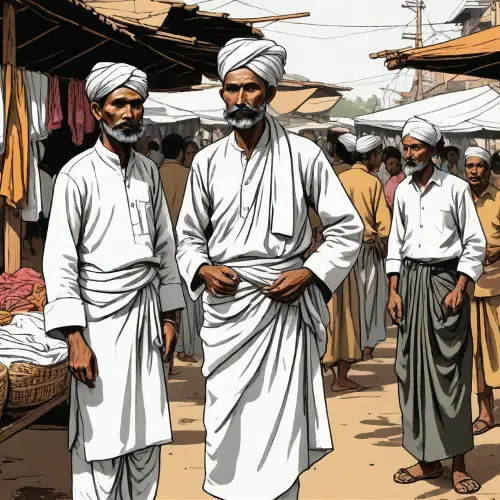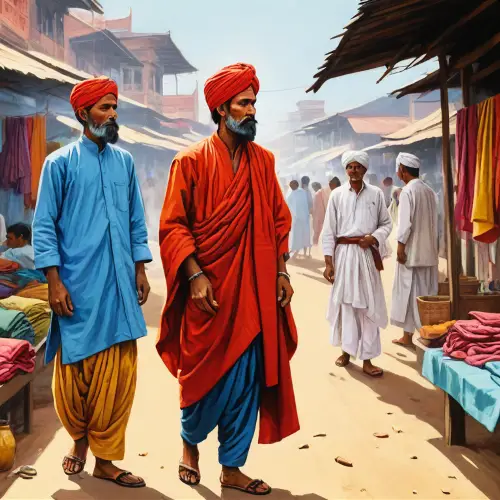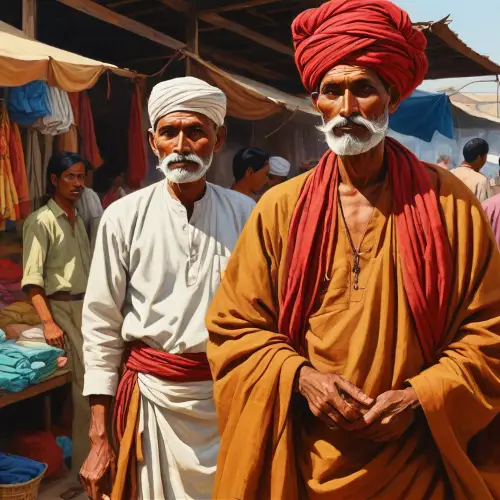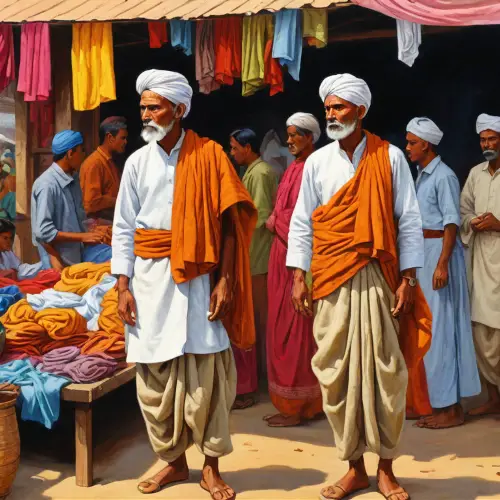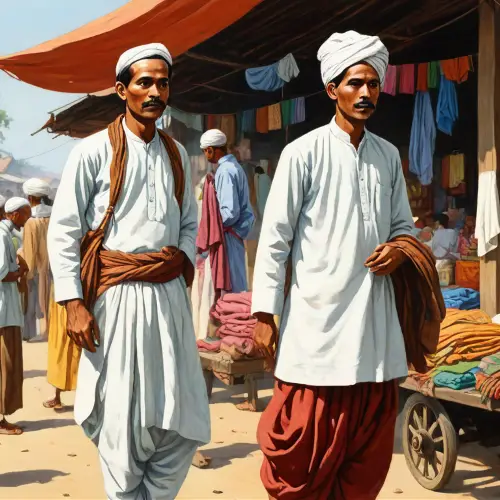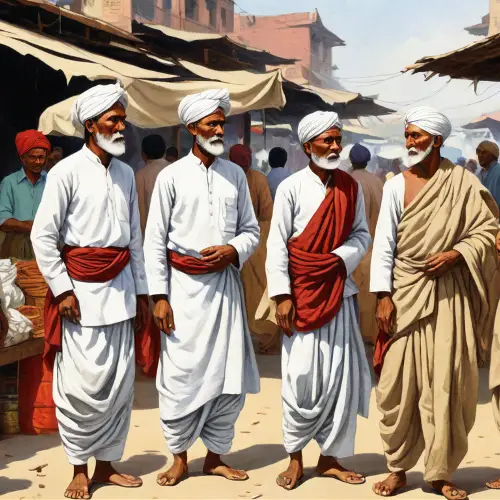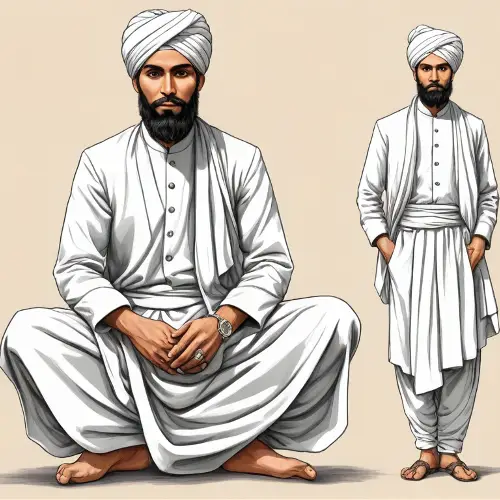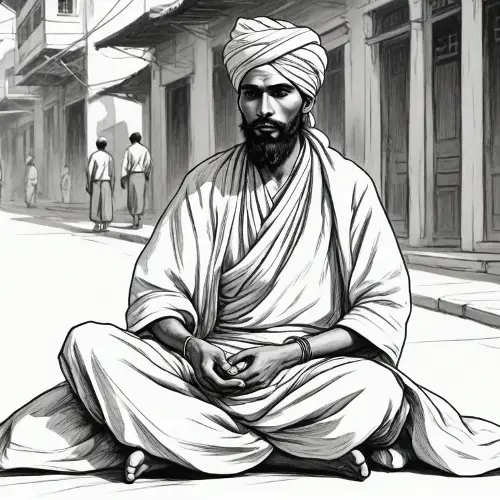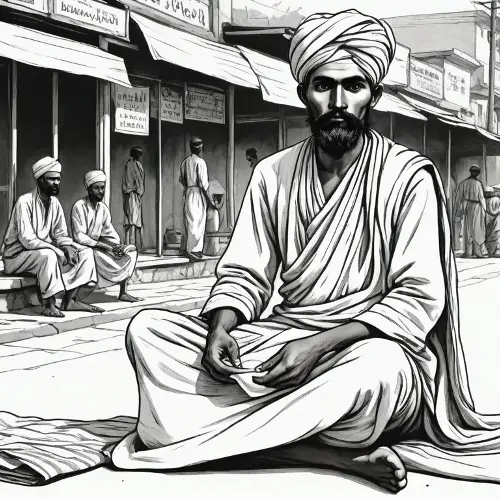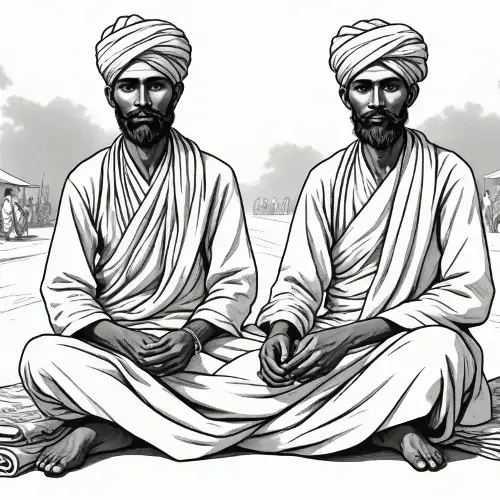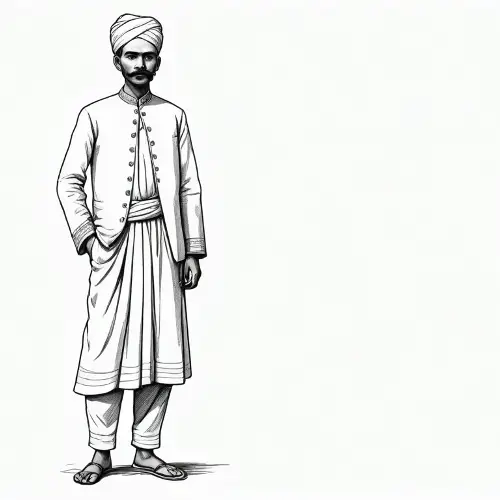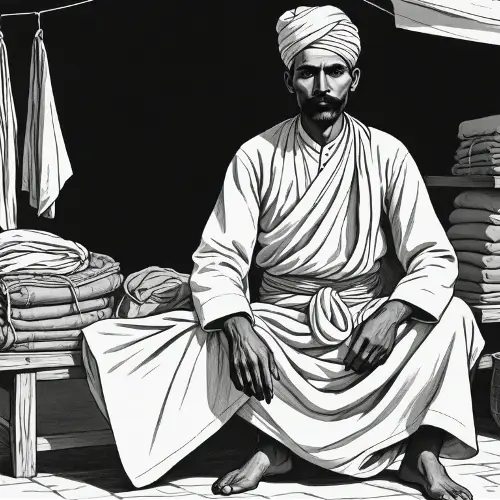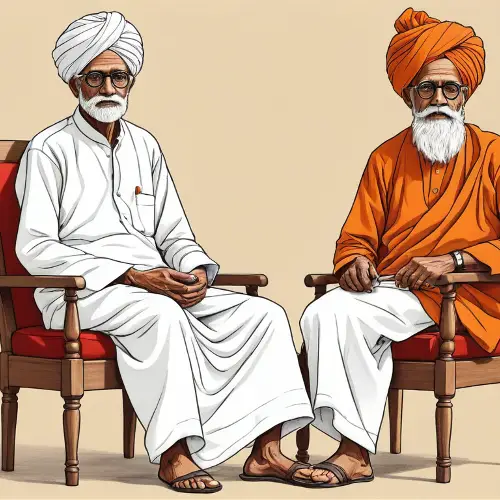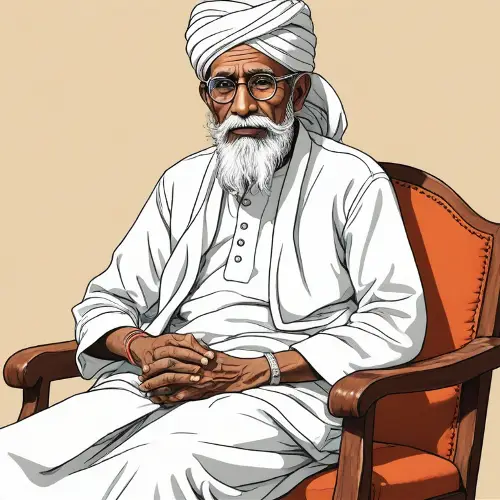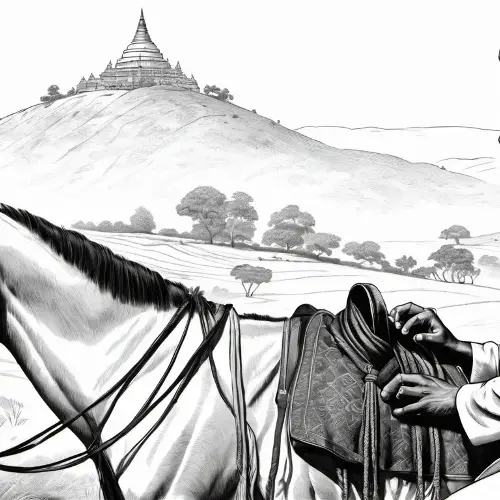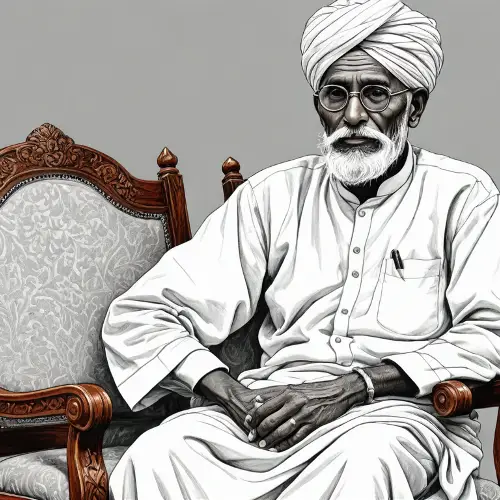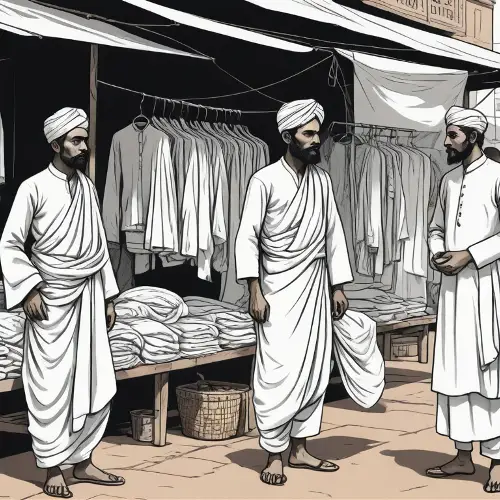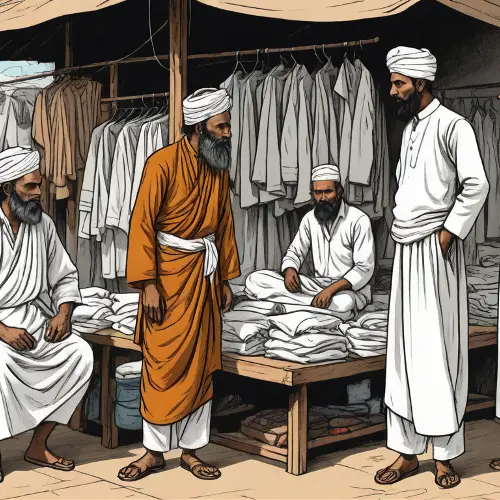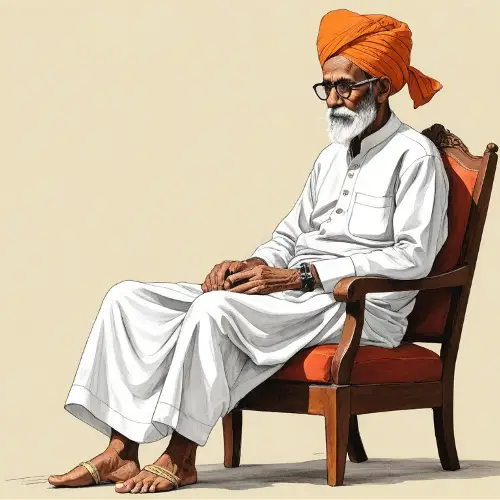Title: \Roadside Elegance: Marwadi Merchant in Mandalay, 1880\ Description: Sketch a serene side view of a Marwadi man, elegantly seated on the bustling market road of Mandalay in 1880. The focus is on capturing the quiet dignity and cultural richness of the merchant as he faces left, surrounded by the energy of the vibrant marketplace. Detail the Marwadi mans attire with precision, emphasizing the graceful folds of the dhoti, the intricate patterns of the kurta, and the distinctive style of the turban on his head. Illustrate the textiles he is selling, playing with colors and textures to evoke the vibrancy of the market. Frame the scene to showcase the historical elements of the Mandalay market road, including nearby stalls and architectural details that transport viewers to the late 19th century. Convey the movement of people passing by, creating a sense of the lively street environment. Highlight the Marwadi merchants profile, capturing the expressions on his face as he engages with customers and manages his goods. Utilize shading and lighting to add depth and atmosphere, creating a visually compelling side view of the cultural exchange taking place on the historic road. This sketch aims to immerse viewers in the elegance and cultural significance of a Marwadi merchant seated on a Mandalay road in 1880, offering a glimpse into the timeless beauty of this historical moment. black and white. greyscale
More Like This
Title: \Roadside Elegance: Marwadi Merchant in Mandalay, 1880\ Description: Sketch a serene side view of a Marwadi man, elegantly seated on the bustling market road of Mandalay in 1880. The focus is on capturing the quiet dignity and cultural richness of the merchant as he faces left, surrounded by the energy of the vibrant marketplace. Detail the Marwadi mans attire with precision, emphasizing the graceful folds of the dhoti, the intricate patterns of the kurta, and the distinctive style of the turban on his head. Illustrate the textiles he is selling, playing with colors and textures to evoke the vibrancy of the market. Frame the scene to showcase the historical elements of the Mandalay market road, including nearby stalls and architectural details that transport viewers to the late 19th century. Convey the movement of people passing by, creating a sense of the lively street environment. Highlight the Marwadi merchants profile, capturing the expressions on his face as he engages with customers and manages his goods. Utilize shading and lighting to add depth and atmosphere, creating a visually compelling side view of the cultural exchange taking place on the historic road. This sketch aims to immerse viewers in the elegance and cultural significance of a Marwadi merchant seated on a Mandalay road in 1880, offering a glimpse into the timeless beauty of this historical moment.charcoal style.
Sketch a vibrant scene set in the bustling streets of Mandalay in 1880, where a Marwadi man, adorned in traditional attire—a dhoti, kurta, and turban—is passionately engaged in selling wares on a lively market road. Detail the Marwadi mans clothing with cultural accuracy, emphasizing the intricate folds of the dhoti, the design of the kurta, and the artistry of the turban on his head. Capture the essence of the vibrant textiles he is offering, with vivid colors and textures that stand out against the backdrop of the market. Illustrate the market road in Mandalay, portraying historical elements such as architectural styles, street vendors, and people engaged in various activities. Convey the energy of the bustling market, with diverse stalls and passersby creating a lively atmosphere.
Create a detailed line art sketch depicting a Marwadi man wearing a traditional dhoti, kurta, and a turban on his head, while sitting on a road and engaged in selling cloth materials on a bustling market road in Mandalay in the year 1880. Capture the intricacies of his attire, the textiles on display, and the historical charm of the market surroundings. Pay special attention to the expression on the merchants face and the unique features of the Mandalay streetscape during this period. Highlight the cultural richness and trade dynamics in this vivid snapshot of 1880 Mandalay. charcoal.
Create a detailed line art sketch depicting a Marwadi man wearing a traditional dhoti, kurta, and a turban on his head, engaged in selling cloth materials on a bustling market road in Mandalay in the year 1880. Capture the intricacies of his attire, the textiles on display, and the historical charm of the market surroundings. Pay special attention to the expression on the merchants face and the unique features of the Mandalay streetscape during this period. Highlight the cultural richness and trade dynamics in this vivid snapshot of 1880 Mandalay. CHARCOAL
Sketch a dreamlike scene where a Marwadi man, adorned in a turban, dhoti, and kurta, is seated on a quaint Burmese road, surrounded by an ethereal atmosphere. The focus is on the serene moment as he passionately sells cloth materials, creating a captivating blend of cultural richness and historical charm. Detail the Marwadi mans traditional attire, paying special attention to the flowing dhoti, intricately wrapped turban, and the details of his kurta.
Sketch a dreamlike scene where a Marwadi man, adorned in a turban, dhoti, and kurta, is seated on a quaint Burmese road, surrounded by an ethereal atmosphere. The focus is on the serene moment as he passionately sells cloth materials, creating a captivating blend of cultural richness and historical charm. Detail the Marwadi mans traditional attire, paying special attention to the flowing dhoti, intricately wrapped turban, and the details of his kurta.
Generate a detailed line art sketch featuring a Marwadi man seated on a Burmese market street in 1887. The man is wearing a traditional turban and dhoti, facing left, and engaged in selling cloth materials on street . Capture the intricate details of his attire, the texture of the fabrics on display, and the historical elements of the bustling Burmese market. Illustrate the street scene with architectural nuances and the lively atmosphere of customers exploring the textile offerings. Emphasize the cultural exchange and trade dynamics in this snapshot of 1887 Burma
Generate a detailed line art sketch featuring a Marwadi man seated on a Burmese market street in 1887. The man is wearing a traditional turban and dhoti, facing left, and engaged in selling vibrant cloth materials. Capture the intricate details of his attire, the texture of the fabrics on display, and the historical elements of the bustling Burmese market. Illustrate the street scene with architectural nuances and the lively atmosphere of customers exploring the textile offerings. Emphasize the cultural exchange and trade dynamics in this snapshot of 1887 Burma
Generate a detailed line art sketch featuring a Marwadi man half seated position on a Burmese market street in 1887. The man is wearing a traditional turban and dhoti, facing left, and engaged in selling cloth materials on street . C historical elements of the bustling Burmese market. Illustrate the street scene with architectural nuances and the lively atmosphere of customers exploring the textile offerings.
Sketch a vibrant scene capturing the cultural dynamism of a Burmese market in 1880, with a focus on a Marwadi man wearing a traditional dhoti and kurta, actively engaged in selling cloth materials while seated. Surround the merchant with the lively atmosphere of the market, including other shops and people engaging in transactions. Detail the Marwadi mans attire with precision, showcasing the intricacies of the dhoti and kurta, and emphasize the array of cloth materials on display. Illustrate the surrounding market scene with architectural elements, such as nearby shops or stalls, and include a diverse group of people, some browsing and others engaged in purchasing textiles.
Create a sketch capturing the cultural fusion in a bustling market scene in Burma circa 1880. Focus on a Marwadi man, dressed in a traditional dhoti and kurta, actively engaged in selling cloth materials. The man could be showcasing vibrant textiles characteristic of Marwadi culture.
Create a sketch capturing the cultural fusion in a bustling market scene in Burma circa 1880. Focus on a Marwadi man, dressed in a traditional dhoti and kurta, actively engaged in selling cloth materials. The man could be showcasing vibrant textiles characteristic of Marwadi culture. Detail the merchants attire, paying attention to the intricacies of the dhoti and kurta, as well as any accessories that might signify his cultural background. Emphasize the array of fabrics and textiles displayed in his stall, depicting the rich colors and textures indicative of the cloth trade during that era. Surround the Marwadi cloth merchant with the diverse sights of the market – other stalls, customers exploring, and perhaps fellow merchants. Incorporate architectural elements of the market, suggesting the traditional structures and ambiance of a Burmese market in the late 19th century. Consider the play of light and shadow on the fabrics, creating depth and visual interest in the scene. Capture the expressions on the faces of the merchant and potential customers, conveying the lively interaction in this cultural exchange. In essence, aim to portray the dynamic cultural commerce as the Marwadi man brings the vibrancy of his textiles to the bustling marketplace of 1880 Burma.
Create a sketch capturing the cultural fusion in a bustling market scene in Burma circa 1880. Focus on a Marwadi man, dressed in a traditional dhoti and kurta, actively engaged in selling cloth materials. The man could be showcasing vibrant textiles characteristic of Marwadi culture. Detail the merchants attire, paying attention to the intricacies of the dhoti and kurta, as well as any accessories that might signify his cultural background. Emphasize the array of fabrics and textiles displayed in his stall, depicting the rich colors and textures indicative of the cloth trade during that era. Surround the Marwadi cloth merchant with the diverse sights of the market – other stalls, customers exploring, and perhaps fellow merchants. Incorporate architectural elements of the market, suggesting the traditional structures and ambiance of a Burmese market in the late 19th century. Consider the play of light and shadow on the fabrics, creating depth and visual interest in the scene. Capture the expressions on the faces of the merchant and potential customers, conveying the lively interaction in this cultural exchange. In essence, aim to portray the dynamic cultural commerce as the Marwadi man brings the vibrancy of his textiles to the bustling marketplace of 1880 Burma.
Create a sketch capturing the cultural fusion in a bustling market scene in Burma circa 1880. Focus on a Marwadi man, dressed in a traditional dhoti and kurta, actively engaged in selling cloth materials. The man could be showcasing vibrant textiles characteristic of Marwadi culture. Detail the merchants attire, paying attention to the intricacies of the dhoti and kurta, as well as any accessories that might signify his cultural background. Emphasize the array of fabrics and textiles displayed in his stall of the cloth trade during that era. Surround the Marwadi cloth merchant with the diverse sights of the market – other stalls, customers exploring, and perhaps fellow merchants. Incorporate architectural elements of the market, suggesting the traditional structures and ambiance of a Burmese market in the late 19th century
line art sketch featuring marwadi man half steated facing left and selling cloth material on wide busy street in 1885
To create a line art sketch of a Marwadi man wearing a turban, dhoti, and kurta, seating on a wide street of Burma in 1880 while selling cloth material, you can follow these steps: Basic Outline: Start with a rough outline of the seated man. Capture the pose with a half-seated position, focusing on the turban, dhoti, and kurta. Clothing Details: Add details to the clothing, emphasizing the folds and patterns of the dhoti and kurta. Pay attention to the turban, ensuring it reflects the traditional style. Seating Position: Define the seating position by sketching the ground or a makeshift seating arrangement. Consider adding a simple depiction of the cloth materials around the man. Street Details: Expand the sketch to include the wide street. Illustrate the ground, and add elements like cobblestones or patterns to suggest the historical setting. Include a hint of surrounding buildings or shops. Cloth Materials: Draw the cloth materials displayed for sale. Use lines and shading to convey the textures and patterns of the fabrics. Consider adding folds and drapes to make the textiles appear realistic. Facial Features: Add facial features to the man, focusing on his expression. Capture the sense of engagement and perhaps a welcoming or contemplative expression. Final Details: Refine the sketch by adding finer details, such as accessories, patterns on the clothing, and any additional elements that enhance the overall composition. Remember, this is a simplified guide, and you can adjust the details based on your preferences and artistic style. Feel free to experiment with different line weights, shading techniques, and textures to bring your sketch to life.
bamboo shop roof Sketch a vibrant scene capturing the cultural dynamism of a Burmese market in 1880, with a focus on a Marwadi man wearing a traditional dhoti and kurta, actively engaged in selling cloth materials while seated. Surround the merchant with the lively atmosphere of the market, including other shops and people engaging in transactions. Detail the Marwadi mans attire with precision, showcasing the intricacies of the dhoti and kurta, and emphasize the array of cloth materials on display. Illustrate the surrounding market scene with architectural elements, such as nearby shops or stalls, and include a diverse group of people, some browsing and others engaged in purchasing textiles.
Generate historically accurate and evocative images depicting a small roadside shop in the bustling Mandalay Market during the year 1867. Transport viewers to the vibrant atmosphere of the era, showcasing the architectural details of the shop, surrounding market stalls, and the daily life of people in Mandalay. Pay attention to period-appropriate clothing, merchandise, and cultural elements. Convey the essence of commerce and daily interactions in this bygone era, capturing the charm and authenticity of a small market stall in Mandalay during the late 19th century
LINE ART SKETCH OF MAN WEARING TURBAN DHOTI KURTA SEATING ON HALF SEATED POSITION ON STREET OF BURMA IN 1880
Generate authentic and visually captivating images depicting a small roadside clothes shop in the bustling Mandalay Market during the year 1867. Transport viewers to the historical setting by capturing the architectural details of the shop, the diversity of textiles and garments on display, and the cultural nuances of clothing styles from that period. Emphasize the interactions between the shopkeeper and potential customers, while also showcasing the vibrant atmosphere of the market. Pay attention to historical accuracy in clothing, architecture, and cultural elements, providing a glimpse into the fashion and commerce of Mandalay in the late 19th century
MARWADI MAN WEARING DHOTI KURTA AND TURBAN SEATING ON ROAD AND SELLING CLOTH MATERIAL IN BURMA IN 1885
MARWADI MAN sitting and WEARING DHOTI AND KURTA AND TURBAN ON HEAD SELLING ON MARKET ROAD IN MANDLAY IN 1880. side view. charcoal style.
Generate realistic and historically accurate images depicting a small roadside clothes shop in the lively Mandalay Market during the year 1867. Detail the shops architecture, textiles on display, and the clothing styles of the time with precision. Capture the hustle and bustle of the market, showcasing authentic interactions between the shopkeeper and customers. Pay meticulous attention to period-specific details such as clothing designs, materials, and cultural nuances. Transport viewers to the vibrant atmosphere of Mandalay in 1867, providing an immersive and realistic portrayal of a small clothes shop amid the historical market setting
Generate realistic and historically accurate images depicting a small roadside clothes shop in the lively Mandalay Market during the year 1867. Capture the hustle and bustle of the market, showcasing authentic interactions between the shopkeeper and customers. Transport viewers to the vibrant atmosphere of Mandalay in 1867.
marwadi man wearing dhoti and kurta selling clothes material burma in 1880
marwadi man wearing dhoti and kurta selling clothes material BY SEATING IN burma MARKET in 1880
MARWADI MAN WEARING DHOTI AND KURTA AND TURBAN ON HEAD SELLING ON MARKET ROAD IN MANDLAY IN 1880. side view. charcoal style
Create a minimalist one-line sketch featuring a 60-year-old Marwari man in a dhoti and Rajasthani turban, seated on a Burmese comfort chair with a side view. Highlight the essential details such as the turban, dhoti folds, and the silhouette of spectacles, capturing the fusion of Marwari and Burmese cultural elements in a single continuous line. line sketch
Generate evocative and historically accurate images depicting a indian man wearing a turban peacefully eating in the serene hills of Myanmar in the year 1837, with his horse tied nearby. Capture the tranquility of the moment, emphasizing the cultural significance of the turban, the traditional attire, and the picturesque Myanmar hills. Pay meticulous attention to historical details, including clothing styles, landscape features, and the interaction between the man, his meal, and the tied horse. Convey the timeless connection between individuals, nature, and animals within the historical context of Myanmar in 1837
Create a powerful black and white line art drawing featuring a 24-year-old Marwadi boy, the owner of a factory in Myanmar. In this intense scene, portray him passionately directing and giving instructions to his subordinates on the factory floor. The shading should add depth and dimension to the drawing, emphasizing the contrast between light and shadow. Key Elements: Marwadi Owner: Illustrate a young, assertive Marwadi man in his mid-20s, dressed in contemporary business attire, reflecting his role as a factory owner. Factory Setting: Utilize varying line weights and shading to depict the factory floor in Myanmar, emphasizing machinery, workers, and the industrial environment. Expressive Gestures: Use bold lines to showcase the young owner energetically shouting and giving directions to the workers, emphasizing the intensity and passion in his managerial approach. Subordinates at Work: Employ fine lines and shading to illustrate the workers diligently carrying out their tasks, responding to the owners instructions, and showcasing the diverse workforce in the factory. Facial Expressions: Utilize shading to highlight facial expressions, conveying a mix of determination, urgency, and cooperation between the owner and the workers. Additional Details: Apply shading techniques to create depth and contrast in the industrial setting. Consider using cross-hatching or stippling for shading, adapting to the grayscale aesthetic.
\"Generate a finely detailed line drawing depicting a 60-year-old Marwari man seated on a Burmese comfort chair, showcasing his side profile. The man is attired in a classic dhoti, complemented by a white Rajasthani turban. Pay special attention to the folds and textures of the dhoti, and capture the intricate details of the turban. Ensure that the man's spectacles are intricately portrayed, and emphasize the cultural fusion in this cross-cultural representation. Utilize precise lines and shading to convey the essence of the man's attire and the unique Burmese comfort chair.\" pencil drawing.
marwadi man wearing dhoti and kurta selling clothes material BY SEATING IN burma MARKET in 1880 with some shop surrounding it and people buying it
Create a minimalist one-line sketch featuring a 60-year-old Marwari man in a dhoti and Rajasthani turban, seated on a Burmese comfort chair with a side view. Highlight the essential details such as the turban, dhoti folds, and the silhouette of spectacles, capturing the fusion of Marwari and Burmese cultural elements in a single continuous line


